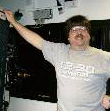|
|
This topic comprises 3 pages: 1 2 3
|
|
Author
|
Topic: some history on the shuttle Columbia...
|
Darryl Spicer
Film God

Posts: 3250
From: Lexington, KY, USA
Registered: Dec 2000
|
 posted 02-02-2003 01:27 PM
posted 02-02-2003 01:27 PM



I decided to make this a seperate thread from the current one. We can use that one to post condolences and this one to post anything about the shuttle or events related to the accident....
NASA weighed retiring Columbia in 2001
Richard Stenger CNN
The space shuttle Columbia, lost with its seven-person crew in a catastrophic re-entry accident on Saturday, was considered for retirement in 2001.
The oldest orbiter in the fleet, it had experienced engineering problems before during a long career that begin with the first shuttle mission more than 20 years ago.
Yet none of the previous glitches on Columbia, which underwent a $90 million, 17-month overhaul that began in September 1999, were thought to have contributed to the fatal mishap.
The 90-ton shuttle, heavier than other spacecraft in the fleet, was the only one not outfitted to dock with the international space station.
NASA had considered mothballing it in 2001 because of budget constraints, but decided to keep it in service, in part to ensure flying several scheduled missions.
They included the one known as STS-107, which, after years of delays, went into space in mid-January for a rare mission devoted solely to science.
The $2 billion craft has been part of numerous NASA milestones since becoming the first shuttle to go into orbit in 1981.
In 1999, it deployed the powerful Chandra X-ray space telescope, with the first female commander at the helm, Eileen Collins.
But that mission began with major problems. The shuttle had leaked thousands of pounds of fuel during liftoff, leaving it in a lopsided but functional orbit.
And seconds after launch, a short circuit knocked out computers that controlled two of three shuttle engines.
A backup computer system kicked in, narrowly avoiding the need for an emergency landing.
NASA grounded the fleet for months to inspect and repair exposed wiring on the four orbiters. Each has 100 miles of electrical wiring.
On the most recent, fatal flight, NASA technicians reviewing video noticed that a number of heat insulation tiles seemed to have fallen off from one of the wings during the shuttle's eight-minute race to orbit.
The tiles protect the shuttle from the intense friction heat of atmospheric re-entry. Similar instances have happened in the past but whether their loss this time played a role in the disaster remains unknown.
| IP: Logged
|
|
Darryl Spicer
Film God

Posts: 3250
From: Lexington, KY, USA
Registered: Dec 2000
|
 posted 02-02-2003 01:36 PM
posted 02-02-2003 01:36 PM



Columbia's 16-day mission featured more than 80 experiments ranging from the effects of space travel on astronauts to the possibility of creating a new perfume.
``The folks on the ground were just ecstatic with the amount of science that they were reaping,'' said Ron Dittemore, space shuttle program manager. ``Some of it was - will be - their legacy.''
Some research results were lost forever when the shuttle disintegrated over Texas, others were downloaded to Earth earlier.
Spiders, flowers, cancer cells, ants, carpenter bees, fish embryos, silkworms and rats were all on board.
``I hope they can salvage something,'' said Hideaki Moriyama, a University of Nebraska biochemist who supplied vials of proteins to the flight in hopes of finding clues to diseases like HIV-AIDS, Huntington's and Alzheimer's.
``It took more than four years to prepare those experiments,'' Moriyama said.
Mohamed Abid, aerospace engineer from the University of Southern California, had a combustion experiment on board. He saw video of his tiny fireballs ping-ponging around the shuttle's laboratory, a safely isolated area.
But Abid said the data - designed to help researchers model combustion in car, airplane and rocket engines - was lost.
In another experiment, shuttle crew members collected samples of their own blood, urine and saliva to detect possible bone loss, kidney stones, muscle loss or weakening of immune systems.
Students from Fowler High School in Syracuse, N.Y., also had a hand in the science. They worked with Syracuse University researchers for three years on an experiment to find out whether ants tunnel at a slower rate in microgravity.
Columbia was the first shuttle in three years not headed to the international space station or the Hubble Space Telescope.
The Israel Space Agency and Tel Aviv University sponsored a $2 million experiment on board. It involved aiming a pair of cameras at the Mediterranean and Atlantic in search of huge dust plumes from the Sahara Desert that might affect Earth's climate.
Soon after the cameras were positioned, NASA reported receiving remarkable details of the clouds.
Perhaps the most commercially viable experiment on board was sponsored by International Flavors & Fragrances Inc., which sent a miniature red rose plant with six buds and an Asian rice flower with a jasmine scent. Astronauts extracted and preserved essential oils from the flowers so fragrance experts back home could recreate the smell.
A 1998 space shuttle experiment yielded a new scent incorporated in the perfume Zen, and a body spray called Impulse.
Northeastern University contributed another kind of experiment to Columbia's last flight. They sent zeolites, a kind of crystal, into the weightless environment. The center is working on ways to improve zeolite materials for more efficient storage of hydrogen fuels.
A project by two Arizona State University researchers was to help turn crew member urine and wastewater into clean water for drinking, cooking and bathing.
David Warmflash, a scientific investigator with the Johnson Space Center, had been expecting to study bacteria cultures brought back to space Saturday afternoon. Instead, he was mourning the fate of the shuttle.
``It's just one more experiment for us,'' Warmflash said. ``It's not in the same category as losing a crew.''
One of the experiments Warmflash worked on, examining how well bacteria grew on rocks in space, was put together by an Israeli graduate student and a Palestinian undergraduate studying in the United States.
``In space, you find your similarities outweigh any differences,'' Warmflash said.
| IP: Logged
|
|
|
|
|
|
|
|
|
|
|
|
|
|
|
|
|
|
|
|
Will Kutler
Phenomenal Film Handler

Posts: 1506
From: Tucson, AZ, USA
Registered: Feb 2001
|
 posted 02-03-2003 06:40 PM
posted 02-03-2003 06:40 PM




Several topics to cover here.....
As an Aircraft Mechanic and Machinist, I can offer the following:
First, those tiles are amazing. One of my college instructers, who is a Metalurgist specializing in Failure Analysis at the University of AZ brought one of the tiles into class. He proceeded to put the tile in our heat treat oven at a few thousand degrees F for a couple of hours. A few minutes before the end of class, he removed the tile and was immediatly able to hold it in his hand and pass it around! These tiles are a VERY light-weight material and are sure something to behold.
What is now being said is that budget cuts and politics are jeopardizing safety at N.A.S.A. As an Aircraft Mechanic, college trained with both civilian and military experience on both heavy and light aircraft, I can definately relate to this! One of the things that was instilled into me by my teachers was to beware of being pressured into preforming jury-rigged maintenance by politically motivated supervisors and private aircraft owners. God, how they were right! I lost track of how many times in both the civilian sector and military I was pressured into doing just that! My conscious is clear because I was able to resist that pressure...but in doing so I did get myself into political trouble! In fact, last year, at a major Tucson maintenance facility, a mechanic was pressured into preforming jury-rigged maintenance. He resisted, and this resulted in his employment being jeopardized. Luclily, he was able to document what happened and won a $1.5 million settlement in court! And by the way, did not politics and jury-rigged maintenance surrounding the O-Ring lead to the previous Shuttle disaster in 1986?
There is also talk regarding the Shuttles' age. Keep in mind that in the aerospace industry component and system lifespan is measured in hrs of operation (service) or cycles, example being that each time an airframe is pressurized and depressurized this is considered to be a cycle. After so many cycles, the airframe structure will begin to weaken. However, there are intense F.A.A. instuted airframe overhaul procedures by which an airframe can be returned to 0 hrs. Also keep in mind that many of the C-141s and C-5 A/B aircraft in the USAF have exceeded their "rated" lives by literally thousands of hours. So, considering the Shuttles' age, I do not know what does or does not apply...or how a thourough overhaul would affect the airframe.
| IP: Logged
|
|
|
|
|
|
|
|
|
|
All times are Central (GMT -6:00)
|
This topic comprises 3 pages: 1 2 3
|
Powered by Infopop Corporation
UBB.classicTM
6.3.1.2
The Film-Tech Forums are designed for various members related to the cinema industry to express their opinions, viewpoints and testimonials on various products, services and events based upon speculation, personal knowledge and factual information through use, therefore all views represented here allow no liability upon the publishers of this web site and the owners of said views assume no liability for any ill will resulting from these postings. The posts made here are for educational as well as entertainment purposes and as such anyone viewing this portion of the website must accept these views as statements of the author of that opinion
and agrees to release the authors from any and all liability.
|

 Home
Home
 Products
Products
 Store
Store
 Forum
Forum
 Warehouse
Warehouse
 Contact Us
Contact Us




 Printer-friendly view of this topic
Printer-friendly view of this topic

















